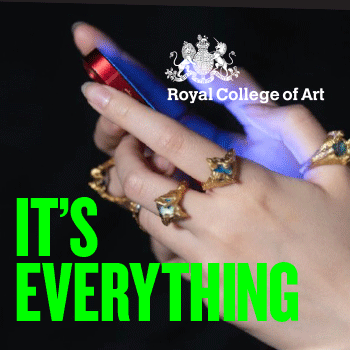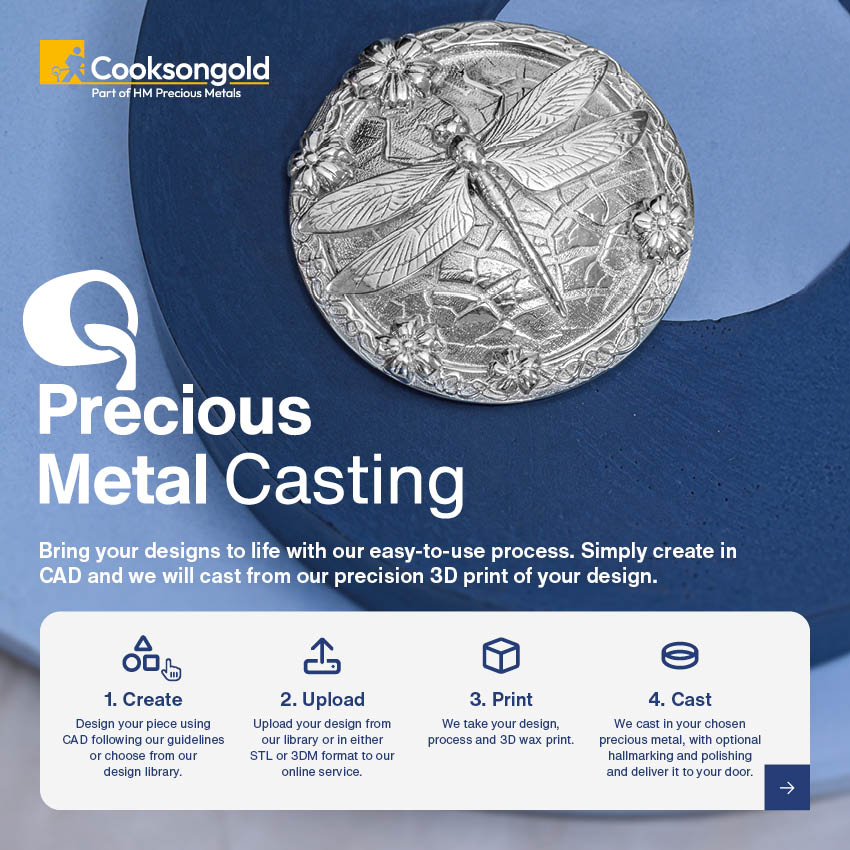Olympic and Paralympic Medals
Paris 2024's Olympic and Paralympic Medals
Reading Time:
1 min {{readingTime}} mins
When Paris 2024 revealed the medals for the upcoming Olympic and Paralympic Games in February the designs were launched with the representation of the concept of the meeting of the most wanted object of the Games with the iconic symbol of France and Paris, the Eiffel Tower.
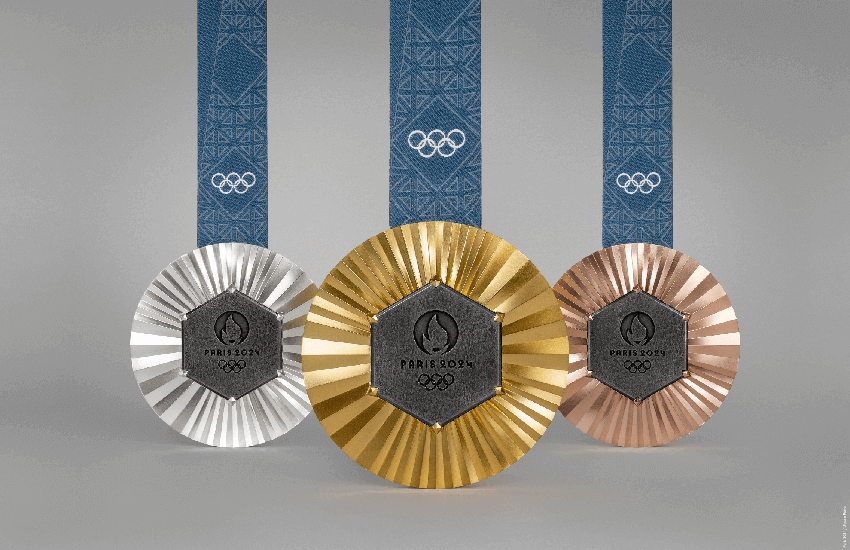
Each medallist over the last two weeks and over the Paralympics will receive a piece of original iron from the Eiffel Tower placed at the heart of their medal. To create their design, Paris 2024 called on its Athletes' Commission and the expertise of Chaumet, a LVMH Group company and Premium Partner of the Olympic and Paralympic Games Paris 2024.
The designs were launched with Tony Estanguet, President of Paris 2024 and three-time Olympic champion; Antoine Arnault, Environment & Image LVMH; Martin Fourcade, President of the Paris 2024 Athletes' Commission, former biathlete and five-time Olympic champion; Béatrice Hess, former swimmer with 20 Paralympic titles; Alex Portal, silver and bronze medal-winning swimmer at the Paralympic Games and qualified for Paris 2024; Koumba Larroque, third in the 2023 World Wrestling Championships and qualified for Paris 2024; and Pauline Déroulède, three-time French champion and France's No. 1 wheelchair tennis player.
By involving the Paris 2024 Athletes' Commission, chaired by Martin Fourcade, in the creative choices for the design of the medals for the upcoming Games, Paris 2024 wanted to ensure that the object dreamt up by the athletes was truly made for them by imagining it with them.
Alongside Paris 2024 and its Athletes' Commission, the craftspeople of Chaumet, the LVMH group's House of Jewellery, have brought all their creativity and expertise to magnify the medals. Each element of their design reflects a part of the identity of the Olympic and Paralympic Games Paris 2024.
Paris 2024 reaffirmed its goal of bringing the Olympic and Paralympic Games closer together, with the “Eiffel Tower side” shared by both the Olympic and Paralympic medals. Because the Olympic Games and the Paralympic Games each have their own history, two unique stories are being written on the other side of the medals. The Eiffel Tower also has its place, as a signature element of the Paris 2024 medals.
To celebrate the return of the Games to France, each Games medal is embellished with an original piece of the Eiffel Tower. To create this meeting between the most prestigious object of the Games and the iconic monument of France and Paris, Paris 2024 worked on the design of the medal with Chaumet, an LVMH Group company which is a Premium Partner of Paris 2024.
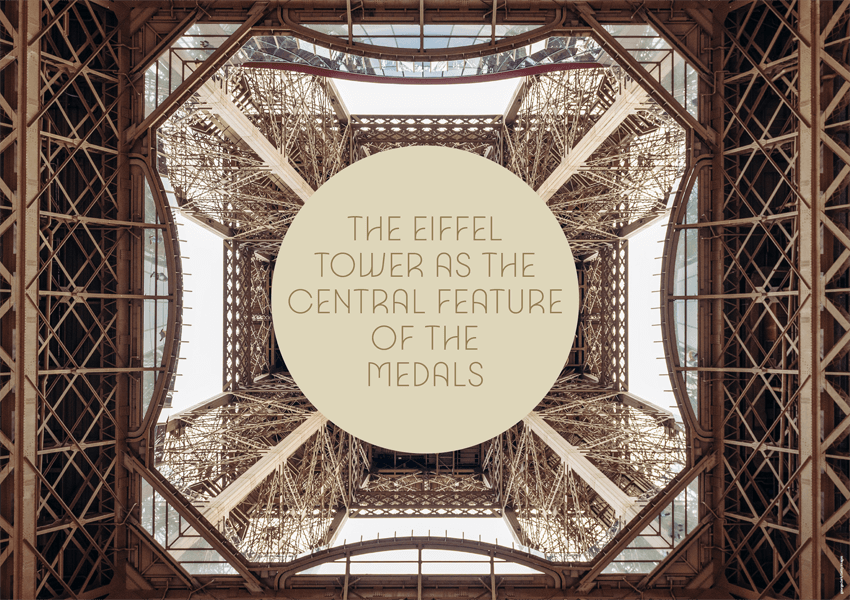
A Piece Of The Eiffel Tower In Every Medal
Winning a medal at the Games can change a life. Every athlete dreams of it, so it was only appropriate that they were involved in the design process for the medals of the Paris 2024 Games. The Paris 2024 Athletes’ Commission, chaired by Martin Fourcade, participated in the search for an idea to symbolise the identity of the next Games. The winning idea was an obvious choice: to associate the iconic monument of France and Paris—the Eiffel Tower —with the most prestigious object of the Games: the medal.
Each Olympic and Paralympic medal is set with a piece of original iron from the Eiffel Tower. Built between 1887 and 1889, the “Dame de fer” has since undergone numerous renovations. Certain metallic elements have been permanently removed and conserved in this process. For the Paris 2024 Games, the Eiffel Tower Operating Company is allowing these genuine pieces of Parisian and French history to find glory again.
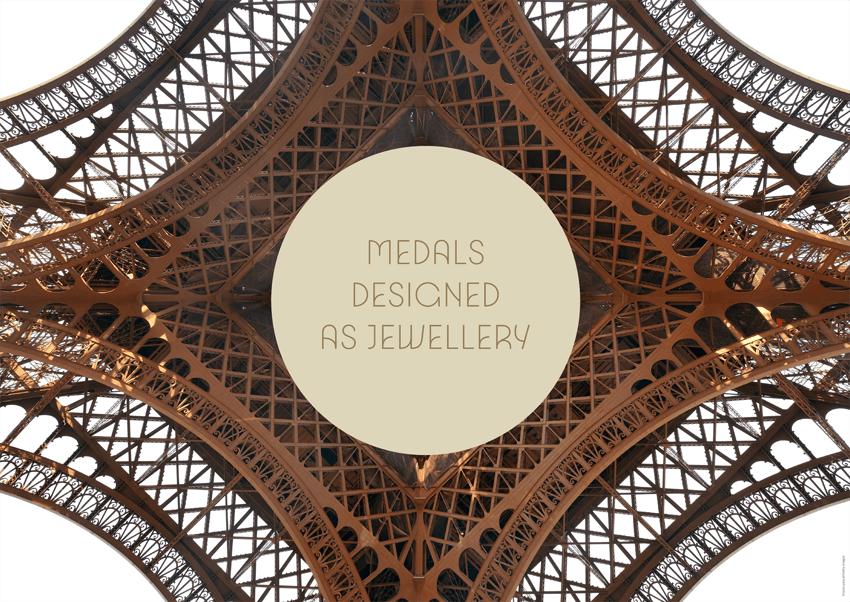
Designing The Medals
Paris 2024 called on LVMH jeweler Chaumet to design its medals. Globally renowned for its craftsmanship, Chaumet has made the medal into a veritable jewel, with a construction conceived around three sources of inspiration: the hexagon, radiance, and gem-setting.
A Parisian Jeweller
Founded in the heart of Paris in 1780, the House of Chaumet has embodied Parisian spirit for over 240 years. Established on the Place Vendome in 1812, Chaumet’s major clients have included many famous figures, including Gustave Eiffel, who commissioned some superb orders. Chaumet has also always asserted its Parisian identity through its creations, including a pendant representing the Vendôme Column and an Eiffel Tower brooch. By designing the medals for the Olympic and Paralympic Games Paris 2024, Chaumet is perpetuating this creative tradition with the extra soul and meaning that often characterise French spirit. The result is a design that captures the spirit of the times and plays with light. Inspired by motifs from the past, Chaumet delivers an innovative aesthetic that is deeply rooted in the present. Chaumet’s creative teams were keen to draw inspiration from the House’s heritage and archives, and chose three timeless elements as a nod to the past for an eternal medal.
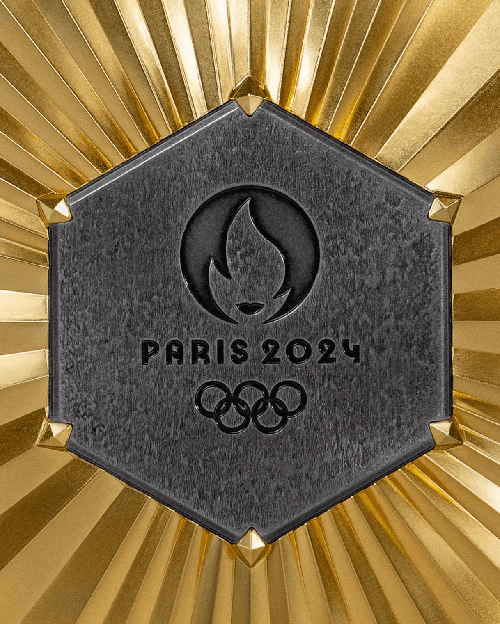
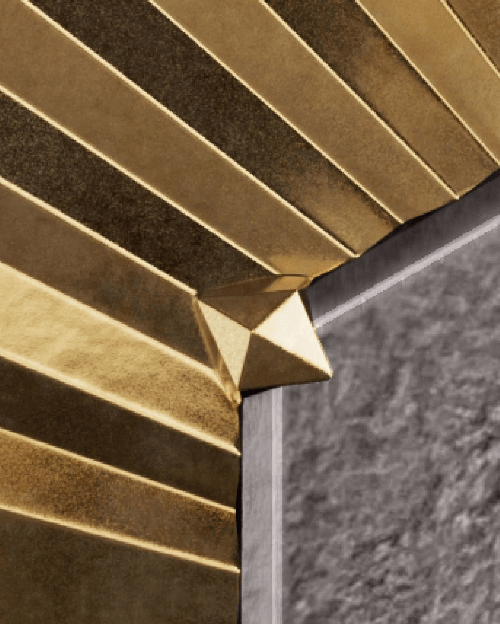
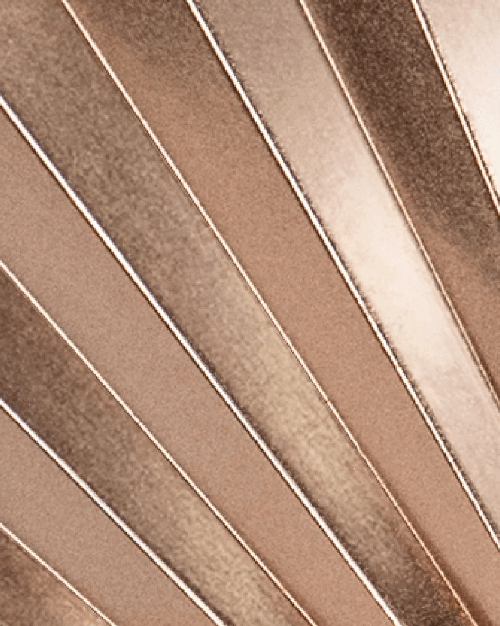
The Hexagon
The original Eiffel Tower iron is formed in a hexagon — the geometrical shape of France herself. This symbol is a reminder of the whole nation’s engagement in delivering an historic Olympic and Paralympic Games. Stripped of its “Eiffel Tower brown” paint, the iron is returned to its original colour. Placed in the centreand imprinted with the emblem of the Paris 2024 Games, this piece of heritage fits perfectly within the gold, silver and bronze core of the medal.
Radiance
On the same side of the medal, fine lines project outwards at regular intervals from around the iron hexagon. Embossed rather than engraved, these lines bring relief and sparkle to a medal that is far from being smooth. This creative concept embodies both the radiance of France in the world and the shining performances of the athletes at the Games.
Setting The Gem
In order to bring together the icons of the Eiffel Tower and the medal of the Games, an equally symbolic craft was required. Thanks to the creativity of LVMH and the House of Chaumet, the medal is encrusted with a piece of iron from the Eiffel Tower. Six metal appendages —one for each are used to fix the hexagon in place. This encrusting is possible due to the slightly concave shape of the medal, which adds depth to the design of each side. For Paris 2024, the distinctive “Clous de Paris” hobnail shape that resembles the famous Eiffel Tower rivets has been chosen for the setting.
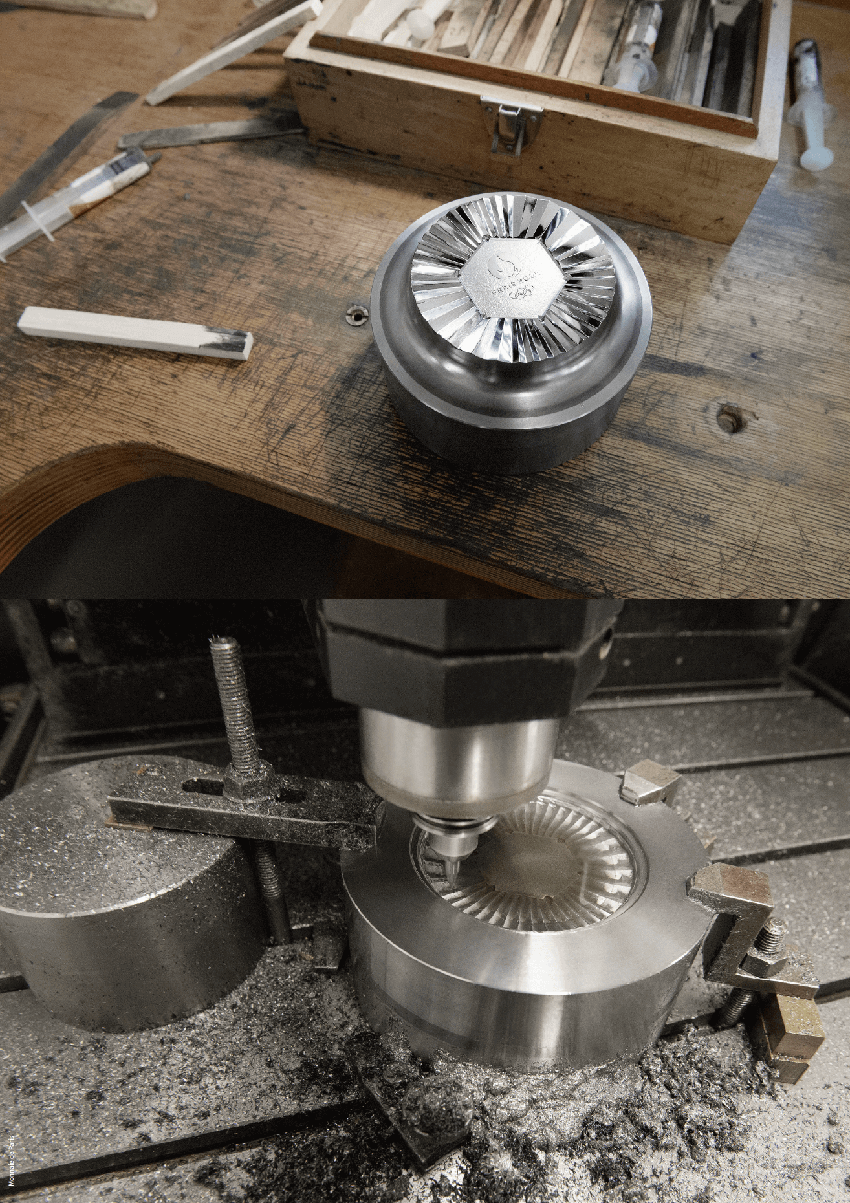
Medals Struck In The Heart
OF PARISDesigned on the right bank of the Seine, at Place Vendôme, the medals for the Olympic Games Paris 2024 are being manufactured on the left bank, at the Hôtel de la Monnaie (French Mint), located on the quai de Conti.
One hundred years after producing the medals for the 1924 edition, the Monnaie de Paris is once again applying its expertise to the Games.
To take shape, the medals for the Olympic Games Paris 2024 follow a more complex manufacturing process than that of a coin.
Metal blanks previously cut into discs are sent to the Monnaie de Paris workshop, where they are struck several times in a press equipped with tools specially designed to bring out the design created by Paris 2024 and Chaumet.
As required by the IOC and IPC, the gold and silver medals are made from solid silver with a millesimal fineness of 925. Just like the six grams of gold used in the first place medals, this silver is certified 100% recycled by the Responsible Jewellery Council (RJC), one of the main regulatory bodies overseeing good practice in the supply of gold and precious metals.
For the bronze used in the third-place medals, the copper alloy, tin and zinc come from reused scraps of metal that are a by product of other production processes of the Monnaie de Paris.
Between each strike, the medals are annealed in ovens to restore their original malleability, while a dip in a bath of acid mixed with water, known as “eau-forte”, removes any impurities. It is during a further strike, using polished pressing tools, that the iron hexagons originating from the Eiffel Tower are set into the medals to give them their unique appearance and perfect their identity.
Once the embossing and details appear clearly, the medals undergo a final process to create the “bail”, ie. the gap through which the ribbons are threaded. The bail is integrated within the medals so that they retain a perfectly round shape. Finally, the medals are varnished and matched with their ribbons. Made by looms located in Saint-Étienne, the ribbons of the medals for the Olympic Games Paris 2024 are also the fruit of French expertise and craftsmanship.
Linking The Olympic & Paralympic Medals
Following the unveiling of a single emblem, a duo of identical mascots, a common *‘*look’ and a shared torch, Paris 2024 is continuing its ambition to bring the Olympic and Paralympic Games closer together. The Olympic and Paralympic medals thereby share one side with the same design: the side encrusted with the Eiffel Tower iron.
The Eiffel Tower has also inspired the unique design of the ribbons for the medals. For the Olympic and Paralympic Games Paris 2024, the medal ribbons will be adorned with the Eiffel Tower lattice work. The Olympic medal ribbons will be dark blue, while those of the Paralympic medals will be a deep red—a mix of the first two coats of paint (“Venice red” and “red-brown”) used on the Eiffel Tower.
Two Unique Stories For The Other Side Of The Medals
As with every edition of the Games, the other side of the Olympic medal tells the story of the rebirth of the Games in Greece, an adaptation introduced of the goddess of victory and the stadium for the Olympic Games Athens 2004 designed by Elena Votsi. A traditional feature of the medals since 2004, the goddess of victory Athena Nike is represented in the foreground, emerging from the Panathenaic Stadium that witnessed the revival of the Olympic Games in 1896. The Acropolis of Athens, another compulsory feature of the Olympic medals, is joined by the Eiffel Tower for the first time in the Paris 2024 design. In this way, the inspiration of the ancient Games in Greece, the French origins of the modern Olympic Games and their next edition in Paris are all represented.
The reverse side of the Paralympic medals is a pure reflection of Paris 2024 and Chaumet’s creative choices. A graphic representation of the Eiffel Tower from an upward perspective will give medalists the chance to discover the Eiffel Tower from a rarely seen angle. The words “Paris” and “2024” surround the feet of the tower written in universal Braille, the symbolic language of accessibility and a reference to its French inventor, Louis Braille. To enable athletes with visual impairments to feel the difference between the medals, dashes are engraved on the edge: I for gold, II for silver and III for bronze.
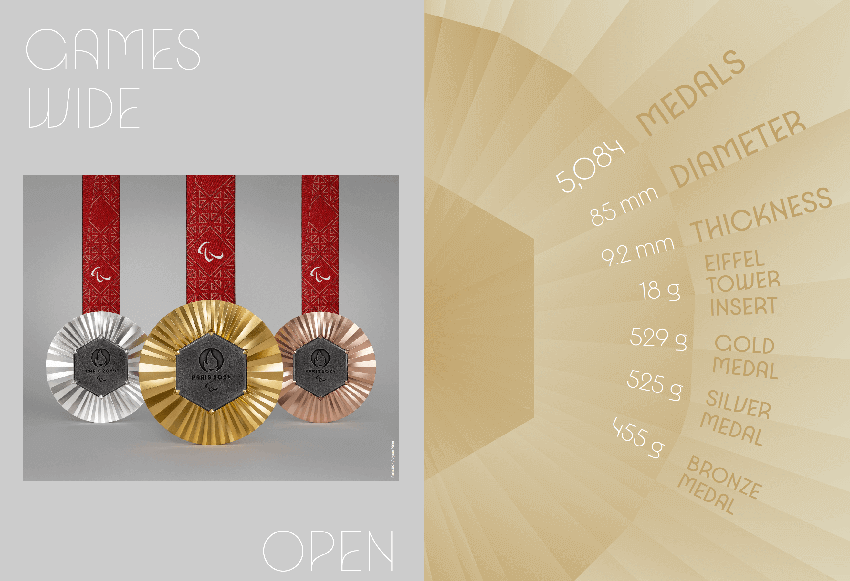
Author:
Published:




